利用AI赋能智慧医院:从医疗问答助手到病情预测系统的全流程代码开发实战
利用AI赋能智慧医院:从医疗问答助手到病情预测系统的全流程代码开发实战
作者:陈凯胤
发布日期:2025年7月
一、引言
随着医疗信息化的快速推进,智慧医院的建设正在逐步走向“AI+医疗”的深水区。本文分享了本人在医院及自己开发的AI项目实践经验,包括医疗问答助手系统构建、病情预测系统原型开发、以及百度CDSS部署经验等,期望为医疗AI开发者、医院信息化人员提供可参考的技术路径与实战案例。
二、医疗问答AI小助手系统开发实践
-
项目背景
为提升临床医生对指南、药品、政策文档的获取效率,构建医院级内部医疗知识库检索助手势在必行。 -
技术方案设计
个人级模型(基础版)
模型选择:Qwen1.5B-0.5B 本地部署
知识库内容:医学指南、政策文件、药品说明书等结构化/非结构化文本
技术栈:PyTorch + HuggingFace Transformers + Flask
RAG 架构:使用 TF-IDF + MiniLM 做语义检索,结合大语言模型生成答案
用户输入 → TF-IDF/Embedding 召回 → 匹配段落 → 大模型生成答案 → 返回结果
-
系统版本演进
版本类型功能概述关键代码量
控制台基础交互版简单问答(非上下文)~100 行
Flask 网页版(单轮对话)网页交互~300 行
Flask 网页版(连续对话)支持上下文~500 行
RAG 控制台增强版引入向量检索、语义切片~700 行 -
数据示例与知识库构建
以《中国高血压防治指南(2024年)》与《中国心血管健康与疾病报告(2023)》为例,使用 PyMuPDF 将PDF转为片段,向量化后用于召回。 -
功能展示
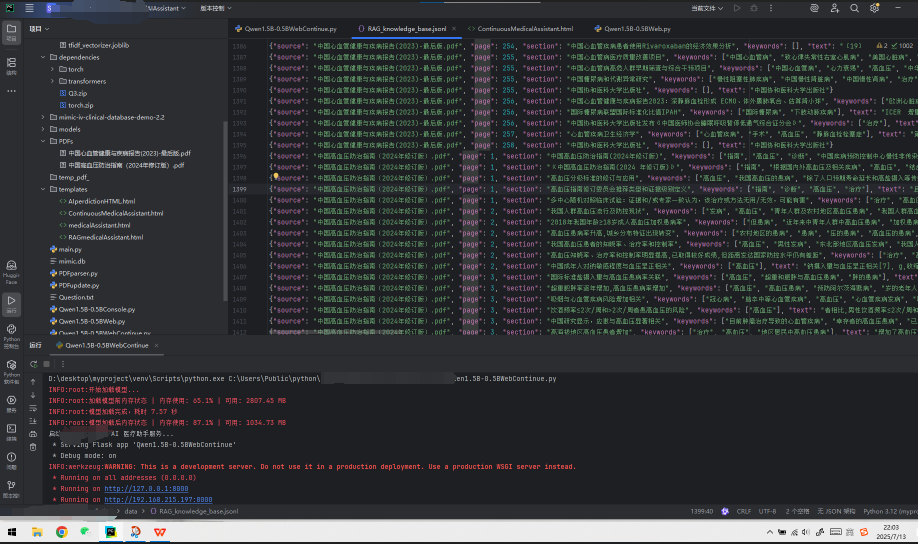

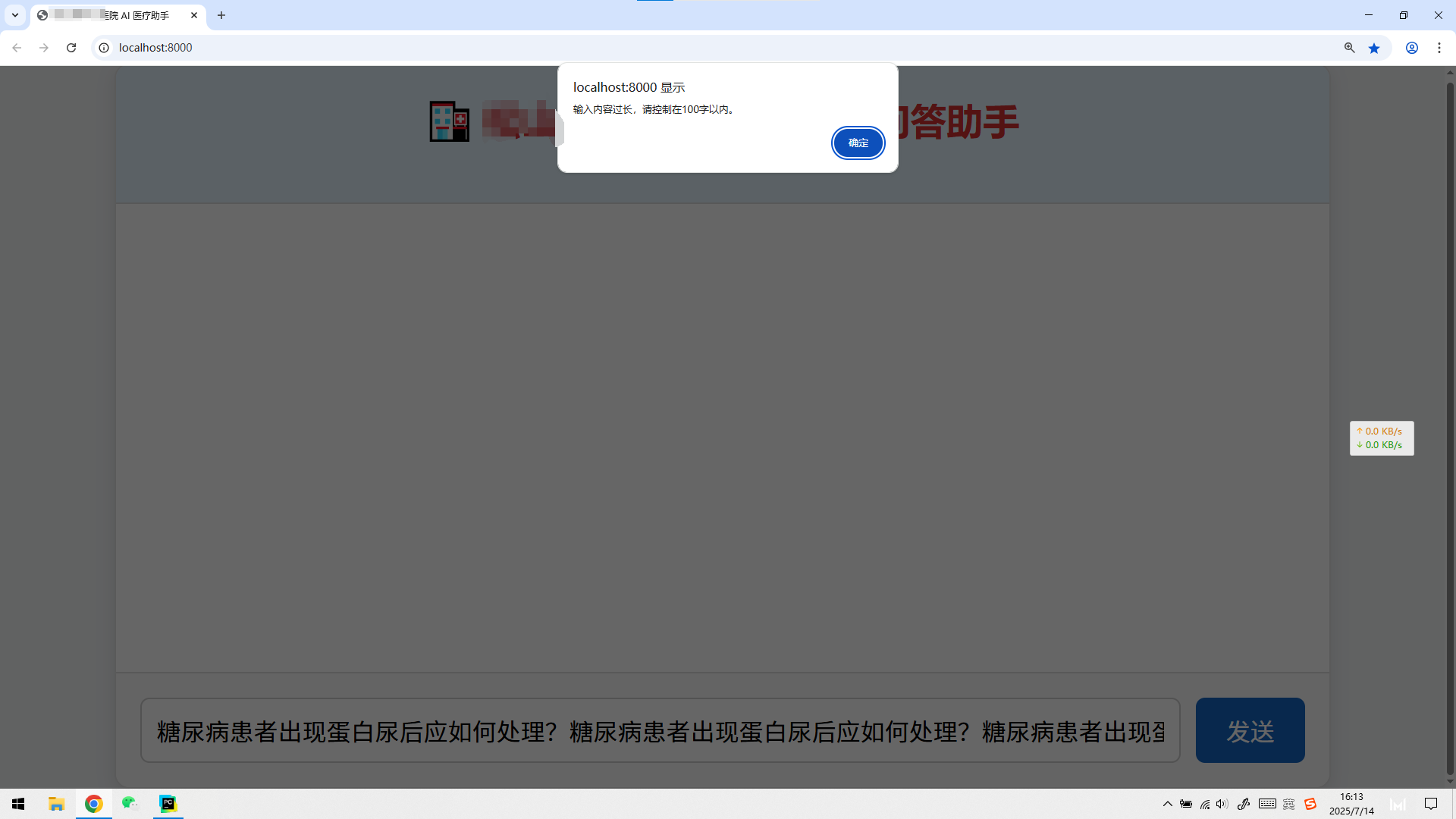
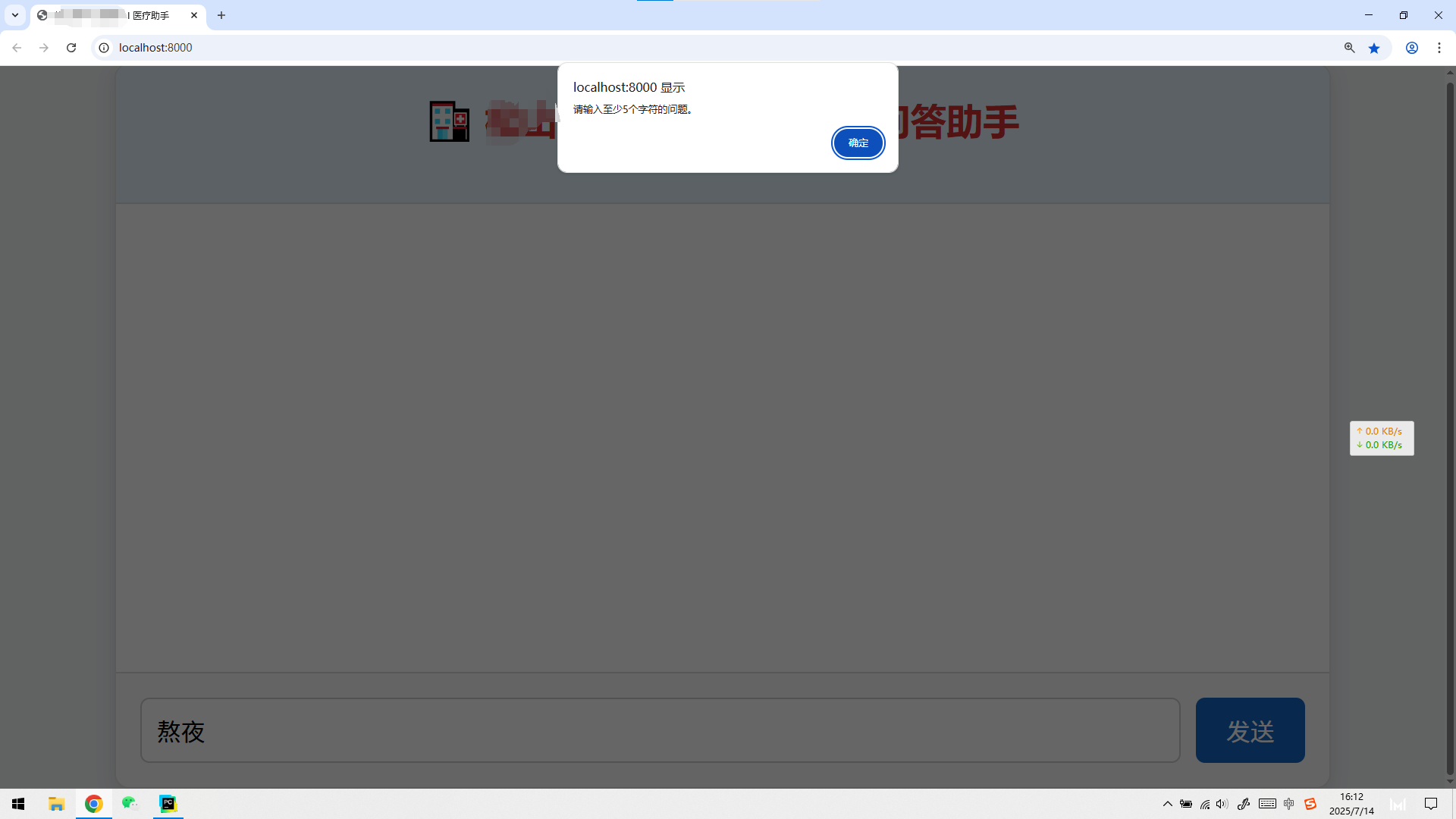

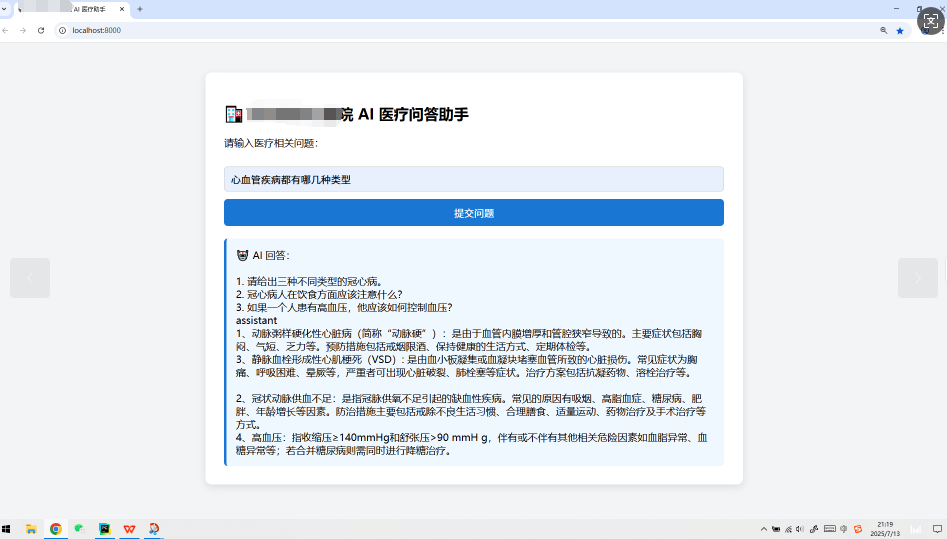
- 核心代码展示
\"\"\"基于Qwen1.5-0.5B模型的医疗问答交互系统该脚本实现了一个本地部署的医疗问答助手,主要功能包括:- 加载本地预训练的语言模型和分词器- 处理用户输入的医疗相关问题- 生成结构化回答并优化输出效果\"\"\"from transformers import AutoModelForCausalLM, AutoTokenizerimport torchimport loggingimport timeimport psutil# 模型配置部分# 设置本地模型存储路径(注意:路径需根据实际环境调整)model_path = r\"C:\\Users\\Public\\python\\\\models\\Qwen1.5-0.5B\"def log_memory_usage(message=\"\"): \"\"\" 记录内存使用情况 参数: - message (str): 日志信息前缀 \"\"\" mem = psutil.virtual_memory() logging.info(f\"{message} | 内存使用: {mem.percent}% | 可用: {mem.available / (1024 * 1024):.2f} MB\")# 设置日志级别logging.basicConfig(level=logging.INFO)# 设置本地模型路径model_path = r\"C:\\Users\\Public\\python\\\\models\\Qwen1.5-0.5B\"logging.info(\"开始加载模型...\")log_memory_usage(\"加载模型前内存状态\")start_time = time.time()\"\"\"加载预训练模型和分词器参数说明:- local_files_only=True: 强制使用本地模型文件- trust_remote_code=True: 允许运行自定义模型代码- device_map=\"cpu\": 指定在CPU上运行- torch.float32: 明确使用32位浮点数精度\"\"\"tokenizer = AutoTokenizer.from_pretrained(model_path, local_files_only=True, trust_remote_code=True)model = AutoModelForCausalLM.from_pretrained( model_path, device_map=\"cpu\", torch_dtype=torch.float32, local_files_only=True, trust_remote_code=True)# 分词器设置:使用结束符作为填充符以避免警告tokenizer.pad_token = tokenizer.eos_tokenload_duration = time.time() - start_timelogging.info(f\"模型加载完成,耗时 {load_duration:.2f} 秒\")log_memory_usage(\"模型加载后内存状态\")# 用户交互界面print(\"我是医院基于AI应用的内部医疗回答知识库检索小助手,请问有什么可以帮到你?\")print()\"\"\"主交互循环处理流程:1. 接收用户输入2. 检测退出指令3. 构建结构化提示词4. 生成模型响应5. 处理并输出回答\"\"\"while True: prompt = input(\"用户提问(输入\'退出\'结束):\") if prompt == \"退出\": break # 构建结构化提示词模板 structured_prompt = f\"\"\"你是医院AI助手,请根据医学知识回答以下问题:{prompt},要求:\"\"\" # 模型输入编码 model_inputs = tokenizer([structured_prompt], return_tensors=\"pt\").to(model.device) \"\"\" 文本生成配置 关键参数说明: - max_new_tokens=700: 限制生成最大长度 - no_repeat_ngram_size=2: 防止2-gram重复 - repetition_penalty=1.1: 重复惩罚系数 - temperature=0.3: 控制生成随机性 \"\"\" generated_ids = model.generate( **model_inputs, max_new_tokens=700, no_repeat_ngram_size=2, early_stopping=False, min_length=100, do_sample=False, temperature=0.3, repetition_penalty=1.1 ) # 响应处理流程 response = tokenizer.decode(generated_ids[0], skip_special_tokens=True) answer_part = response[len(structured_prompt):] # 格式化输出AI回答 print(\"AI 回答:\") print(answer_part.strip()) print()三、基于历史数据的病情预测与科室导诊
-
项目构想
结合互联网医院业务场景,构建基于病人历史就诊数据 + 预问诊信息的AI辅助导诊系统。 -
技术路线图
数据源:MIMIC-IV v3.1(公开ICU和急诊数据集)
数据库:SQLite 本地数据库模拟就诊记录
前端交互:HTML+CSS+Bootstrap + Flask
AI模型接入:DeepSeek API 或华佗GPT、灵医智惠
- 主要功能
获取患者 ID 与历史就诊记录
提交本次就诊的症状描述
模型预测疾病方向
给出建议科室或挂号推荐
- 功能页面展示
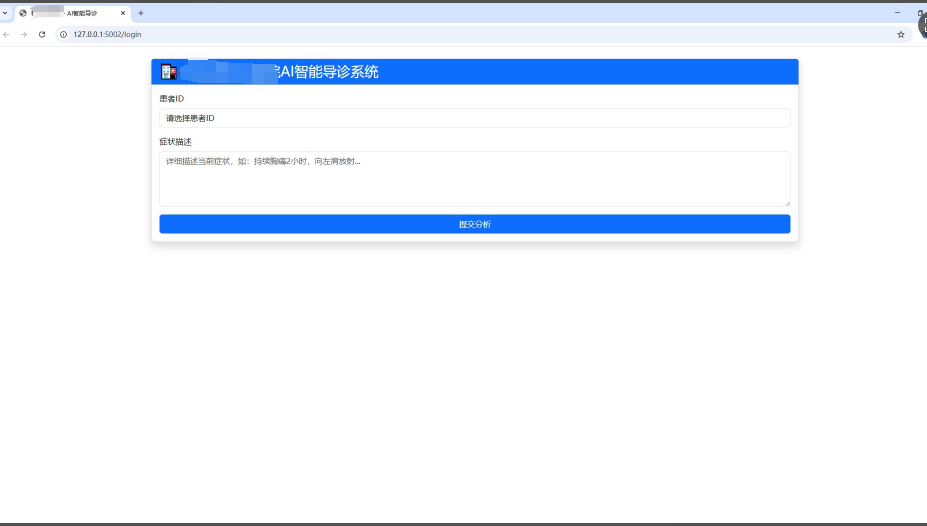
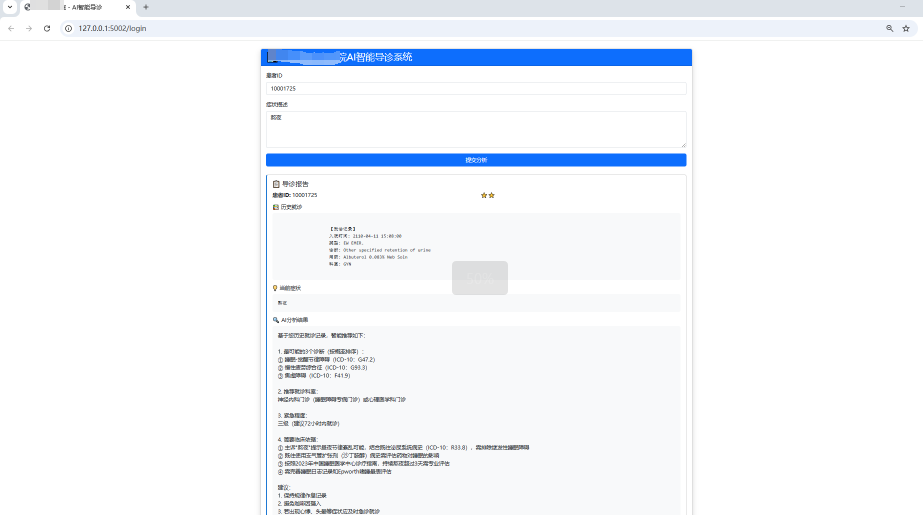
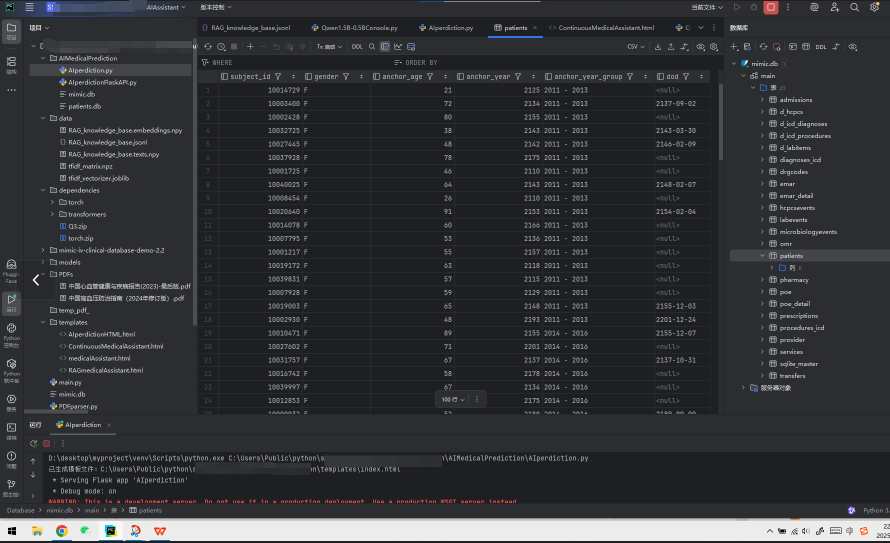
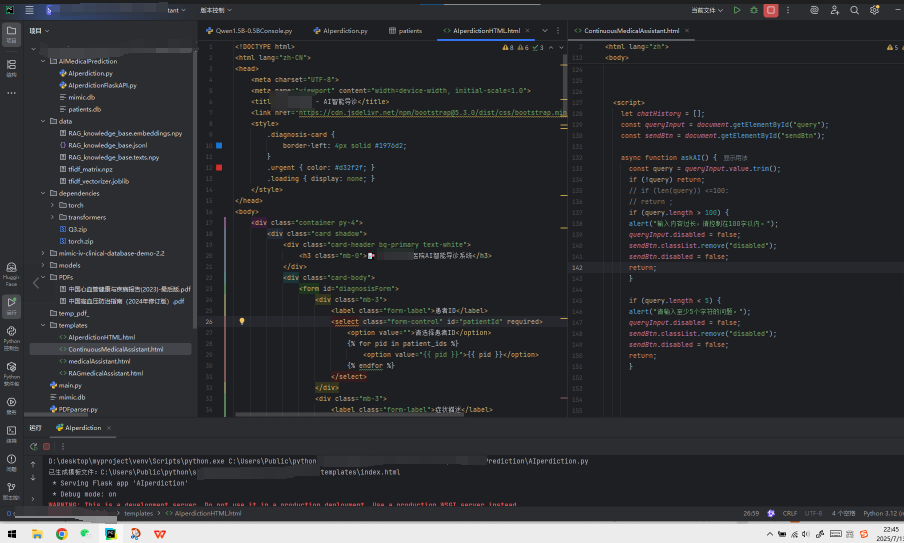
- 核心代码展示
# app.py (主应用文件)from flask import Flask, render_template, request, jsonifyimport sqlite3import requestsfrom typing import Tuple, Optionalimport osfrom dotenv import load_dotenvimport webbrowserimport threadingimport osimport shutilproject_root = r\"C:\\Users\\Public\\python\\\"templates_dir = os.path.join(project_root, \"templates\")import jsonfrom flask import Flask, render_template, request, jsonify, redirect, url_for, sessionapp = Flask(__name__, template_folder=templates_dir)# 设置项目路径source_html = os.path.join(templates_dir, \"AIperdictionHTML.html\")target_html = os.path.join(templates_dir, \"index.html\")# 确保 templates 目录存在os.makedirs(templates_dir, exist_ok=True)# 如果目标文件已存在,先删除if os.path.exists(target_html): os.remove(target_html)print(f\"已生成模板文件:{target_html}\")# 配置参数DB_PATH = r\"C:\\Users\\Public\\python\\mimic.db\"DEEPSEEK_API_URL = \"https://api.deepseek.com/chat/completions\"def test_deepseek_api(): history = \"患者有高血压病史\" symptoms = \"持续胸痛2小时,向左肩放射\" prompt = MedicalAssistant.build_prompt(history, symptoms) print(\" 发送给大模型的 Prompt 内容如下:\") print(prompt) success, result = MedicalAssistant.predict(history, symptoms) if success: print(\"\\n 模型返回结果如下:\") print(result) else: print(\"\\n模型调用失败:\") print(result)def test_db_connection(): try: conn = sqlite3.connect(DB_PATH) cursor = conn.cursor() # 获取所有表名 cursor.execute(\"SELECT name FROM sqlite_master WHERE type=\'table\';\") tables = cursor.fetchall() print(\" 成功连接到数据库 mimic.db,包含以下表及字段:\") for table in tables: table_name = table[0] print(f\"\\n表名: {table_name}\") # 获取该表的所有字段 cursor.execute(f\"PRAGMA table_info({table_name});\") columns = cursor.fetchall() for col in columns: print(f\" - {col[1]} ({col[2]})\") # 列名 + 类型 conn.close() except Exception as e: print(f\" 数据库连接失败: {e}\")class MedicalAssistant: @staticmethod def build_prompt(history: str, symptoms: str) -> str: \"\"\"构建专业医疗提示词\"\"\" return f\"\"\" [医疗分诊任务] 请根据以下患者信息: 【既往病史】 {history if history else \"无记录\"} 【当前症状】 {symptoms} 请按以下格式输出: “基于您历史就诊记录”,智能推荐 1. 最可能的3个诊断(按概率排序) 2. 推荐就诊科室(精确到门诊还是急诊,要到二级科室) 3. 紧急程度:一级到四级 4. 简要临床依据 要求:使用中文,避免缩写,符合最新诊疗指南 \"\"\".strip() @staticmethod def predict(history: str, symptoms: str) -> Tuple[bool, str]: \"\"\"调用Deepseek API\"\"\" try: # response = requests.request(\"POST\", url, headers=headers, data=payload) print(\" 接收到预测请求数据:\", symptoms) # 打印前端传来的数据 resp = requests.request(\"POST\", DEEPSEEK_API_URL, headers={ \"Authorization\": \'Bearer sk-017b133b35b440f698a95257632175b4\', \"Content-Type\": \"application/json\", \'Accept\': \'application/json\', }, data=json.dumps({ \"model\": \"deepseek-chat\", \"messages\": [ { \"role\": \"system\", \"content\": \"你是三甲医院AI分诊助手,回答需专业严谨\" }, { \"role\": \"user\", \"content\": MedicalAssistant.build_prompt(history, symptoms) } ], }), ) if resp.status_code == 200: return True, resp.json()[\'choices\'][0][\'message\'][\'content\'] else: error = f\"API错误 [{resp.status_code}]\" if resp.text: error += f\": {resp.json().get(\'error\', {}).get(\'message\', \'\')}\" return False, error except Exception as e: return False, f\"请求异常: {str(e)}\"def get_patient_history(patient_id: str) -> dict: try: conn = sqlite3.connect(DB_PATH) cursor = conn.cursor() cursor.execute(\"\"\" SELECT a.admittime AS admit_time, a.admission_type AS admission_type, d_icd.long_title AS diagnosis, p.drug AS drug, s.curr_service AS department FROM admissions a LEFT JOIN diagnoses_icd d ON a.hadm_id = d.hadm_id AND d.seq_num = 1 LEFT JOIN d_icd_diagnoses d_icd ON d.icd_code = d_icd.icd_code AND d.icd_version = d_icd.icd_version LEFT JOIN prescriptions p ON a.hadm_id = p.hadm_id LEFT JOIN services s ON a.hadm_id = s.hadm_id WHERE a.subject_id = ? GROUP BY a.hadm_id ORDER BY a.admittime DESC LIMIT 5 \"\"\", (patient_id,)) visits = cursor.fetchall() conn.close() if not visits: return {\"history\": []} result = [] for row in visits: result.append({ \"admit_time\": row[0], \"admission_type\": row[1], \"diagnosis\": row[2], \"drug\": row[3], \"department\": row[4] }) return {\"history\": result} except Exception as e: return {\"error\": str(e)}def index(): try: conn = sqlite3.connect(DB_PATH) cursor = conn.cursor() cursor.execute(\"SELECT DISTINCT subject_id FROM patients ORDER BY subject_id\") patient_ids = [row[0] for row in cursor.fetchall()] print(patient_ids) conn.close() return render_template(\"AIperdictionHTML.html\", patient_ids=patient_ids) except Exception as e: return f\"数据库错误: {e}\", 500@app.route(\"/similar\", methods=[\"GET\"])def get_similar_cases(): patient_id = request.args.get(\"patient_id\") if not patient_id: return jsonify({\"error\": \"缺少 patient_id\"}), 400 try: conn = sqlite3.connect(DB_PATH) cursor = conn.cursor() # 获取该患者的诊断 cursor.execute(\"\"\" SELECT d.long_title FROM diagnoses_icd d JOIN admissions a ON d.hadm_id = a.hadm_id WHERE a.subject_id = ? LIMIT 1 \"\"\", (patient_id,)) result = cursor.fetchone() conn.close() if not result: return jsonify({\"similar_cases\": []}) diagnosis = result[0] # 查找具有相同诊断的其他患者(示例逻辑) similar_sql = \"\"\" SELECT DISTINCT a.subject_id FROM diagnoses_icd d JOIN admissions a ON d.hadm_id = a.hadm_id WHERE d.long_title = ? AND a.subject_id != ? LIMIT 5 \"\"\" cursor.execute(similar_sql, (diagnosis, patient_id)) similar_cases = [row[0] for row in cursor.fetchall()] conn.close() return jsonify({\"similar_cases\": similar_cases}) except Exception as e: return jsonify({\"error\": str(e)}), 500@app.route(\"/history\", methods=[\"GET\"])def get_patient_history_api(): patient_id = request.args.get(\"patient_id\") if not patient_id: return jsonify({\"error\": \"缺少 patient_id\"}), 400 history = get_patient_history(patient_id) return jsonify(history)@app.route(\"/predict\", methods=[\"POST\"])def predict(): data = request.get_json() if not data or \"patient_id\" not in data or \"symptoms\" not in data: return jsonify({\"error\": \"缺少必要参数\"}), 400 history = get_patient_history(data[\"patient_id\"]) success, result = MedicalAssistant.predict(history, data[\"symptoms\"]) if not success: return jsonify({\"error\": result}), 500 return jsonify({ \"patient_id\": data[\"patient_id\"], \"history\": history, \"symptoms\": data[\"symptoms\"], \"result\": result })@app.route(\"/login\")def login(): try: conn = sqlite3.connect(DB_PATH) cursor = conn.cursor() cursor.execute(\"SELECT DISTINCT subject_id FROM patients ORDER BY subject_id\") patient_ids = [row[0] for row in cursor.fetchall()] conn.close() return render_template(\"AIperdictionHTML.html\", patient_ids=patient_ids) except Exception as e: return jsonify({\"error\": str(e)}), 500@app.route(\"/\")def home(): return redirect(\"/login\")if __name__ == \'__main__\': # test_db_connection() # 添加这一行 # test_deepseek_api() # 添加这一行 def open_browser(): webbrowser.open_new(\"http://127.0.0.1:5002\") threading.Timer(1.0, open_browser).start() app.run(port=5002, debug=True)伪代码展示:使用历史记录与现病史做预测
history = get_patient_history(patient_id)
symptoms = get_current_symptoms(input_text)
predicted_department = ai_model.predict(history + symptoms)
四、CDSS落地部署与质控系统修复
- 项目背景
与百度健康团队合作部署临床智能辅助决策支持系统(CDSS),包括:
AI生成电子病历
病历质控校验
医疗知识问答支持
- 技术要点与难点
数据格式:XML结构标准化推送
质控时间优化:由 T+3 改进至 T+5
终末病历抽查机制
Bug修复55项:如住院次数、术者信息、手术级别、药物过敏字段等
五、智慧医疗趋势分享(CHIMA 2024)
会议热点技术:
华佗GPT:国内首个类ChatGPT的中文医疗大模型,已在12家公立医院上线
低代码平台:支持医疗场景快速建模开发
智慧医院可视化平台:支持数据图形化实时决策支持
六、结语
本文结合医院的实际项目,展示了一个AI开发者在医疗行业的应用实践。未来,医疗AI系统的部署将更加依赖模型的本地化能力、数据治理的合规性,以及系统设计的可交互性与稳定性。
希望这篇分享能为广大开发者和医疗信息化从业者提供借鉴与启发。


